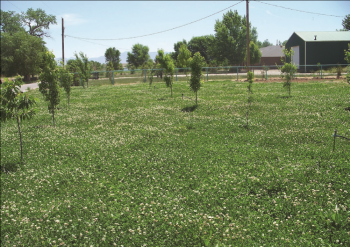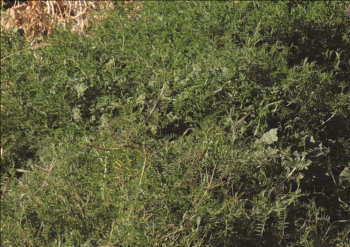Cover Crops


What are Cover Crops?
Cover crops are crops that are grown in between cash crops, intercropped with cash crops, or planted in the absence of a normal crop. They are grown to protect the land from soil erosion and loss of nutrients, and to add organic matter to the soil, which increases the soil microbial populations and diversity.
Why are Cover Crops Important?
When utilizing cover cropping in sustainable agricultural systems, it helps build soil health and makes the soil more resilient to drought and other extreme environmental factors. In arid and semi-arid regions, like New Mexico, there are several benefits when utilizing cover crops.
- Protecting the soil from water and wind erosion. In New Mexico, strong winds occur during the spring and heavy rainfall during monsoon periods. Cover crops helps to ensure that small particles, clay and organic matter, are held in place.
- Adding soil organic matter. Cover crops help to increase the soil organic matter, improving the soil's biological activity, moisture retention, nutrient holding capacity, moisture infiltration, and tilth. These aspects are often limited in soils of arid regions.
- Adding nutrients to the soil. When cover crops are incorporated into and decompose in the soil, valuable nutrients are released for crop use. The delivery rate of nutrients varies among cover crops. Furthermore, nitrogen fixation in legumes can add nutrients to the soil. Symbiotic associations between legumes and bacteria, rhizobia, fix nitrogen and are available for the following cash crop once the legume is incorporated into the soil.
- Serving as a "catch crop". Cover crops essentially "catch" nutrients that are left in the field at the end of the cash crop season. Deep-rooted catch crops are the most beneficial because their root networks extend into the soil profile and absorb nutrients that have gone beyond shallower-rooted cash crops.
- Generally improving soil health. Cover crops provide a number of benefits for soil health. The main benefits for soil health to consider when using cover crops are formation and stabilization of soil aggregates, breaking up soil compaction, improving soil microbial diversity and activity, breaking disease and pest cycles, suppressing weeds through smother and allelopathic effects, and providing habitats for beneficial insects that can prey on field pests.
What are challenges Facing Cover Cropping in Arid and Semi-Arid Regions?
There are many challenges facing growers when considering cover crops. An unfamiliarity regarding cover crops is present and poses questions like which cover crop to select, what is the cost and ease of establishment, and how much water is available to raise cover crops.
Growers are concerned about the cost of seeds, tillage, irrigation, weed control, and termination of the crop, especially in the current challenging economic climate. Because of this, there is a reluctance to grow crops that will not be harvested and will not deliver immediate economic benefit.
Dryland farmers, common in eastern part of New Mexico, are aware of the challenges facing cover crop establishment under the recurrent droughts of this region. Additionally, farmers are concerned that cover crops will extract too much water from the soil profile, thus limiting water that will become available for the following cash crop.
Is it Possible to Overcome the Challenges of Cover Cropping?
An emerging, innovative way for cover-cropping in semi-arid dryland systems is to combine no-till or minimum tillage with cover cropping. Reducing tillage intensity can help improve soil health, promote water infiltration, and reduce evaporative losses during cover crop growth period. Moisture utilization by cover crops is counterbalanced by the improved infiltration and reduced evaporative losses that occur in no-till or minimum tillage systems.
What are Examples of Cover Crops?
There are several examples of cover crops. Please view Table 1.
